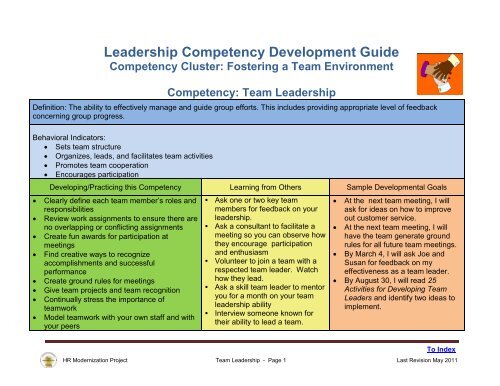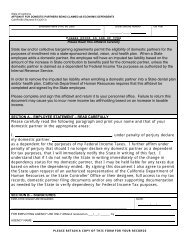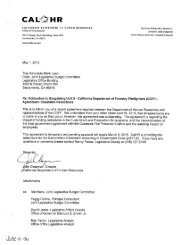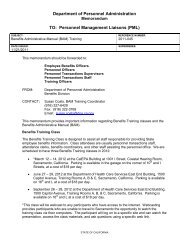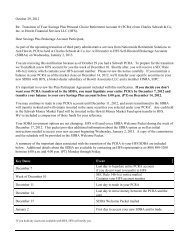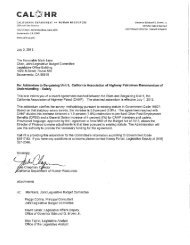Team Leadership - State of California
Team Leadership - State of California
Team Leadership - State of California
Create successful ePaper yourself
Turn your PDF publications into a flip-book with our unique Google optimized e-Paper software.
DRAFT<strong>Leadership</strong> Competency Development GuideCompetency Cluster: Fostering a <strong>Team</strong> EnvironmentCompetency: <strong>Team</strong> <strong>Leadership</strong>Definition: The ability to effectively manage and guide group efforts. This includes providing appropriate level <strong>of</strong> feedbackconcerning group progress.Behavioral Indicators: Sets team structure Organizes, leads, and facilitates team activities Promotes team cooperation Encourages participationDeveloping/Practicing this Competency Learning from Others Sample Developmental GoalsClearly define each team member‟s roles andresponsibilitiesReview work assignments to ensure there areno overlapping or conflicting assignmentsCreate fun awards for participation atmeetingsFind creative ways to recognizeaccomplishments and successfulperformanceCreate ground rules for meetingsGive team projects and team recognitionContinually stress the importance <strong>of</strong>teamworkModel teamwork with your own staff and withyour peers• Ask one or two key teammembers for feedback on yourleadership.• Ask a consultant to facilitate ameeting so you can observe howthey encourage participationand enthusiasm• Volunteer to join a team with arespected team leader. Watchhow they lead.• Ask a skill team leader to mentoryou for a month on your teamleadership ability• Interview someone known fortheir ability to lead a team.At the next team meeting, I willask for ideas on how to improveout customer service.At the next team meeting, I willhave the team generate groundrules for all future team meetings.By March 4, I will ask Joe andSusan for feedback on myeffectiveness as a team leader. By August 30, I will read 25Activities for Developing <strong>Team</strong>Leaders and identify two ideas toimplement.To IndexHR Modernization Project <strong>Team</strong> <strong>Leadership</strong> - Page 1 Last Revision May 2011
DRAFT<strong>Leadership</strong> Competency Development Guidefor <strong>Team</strong> <strong>Leadership</strong>This is not an exclusive list <strong>of</strong> resources. Please feel free to conduct your ownsearch for more resources related to <strong>Team</strong> <strong>Leadership</strong> in civil service.Resources IndexDefinition, Behavioral Indicators,Developmental ActivitiesAcademic Journals and Bookson-line and available for checkoutVideos and Podcastson-line and available for checkoutCourseson-line and for a feeWebinarsOther ResourcesHR Modernization Project <strong>Team</strong> <strong>Leadership</strong> - Page 2 Last Revision May 2011
DRAFTAcademic Journals and BooksOn-Line and Available for CheckoutAcademic Journals and Articles on <strong>Team</strong> <strong>Leadership</strong><strong>California</strong> <strong>State</strong> LibraryAcademic Journals and ArticlesBooks on <strong>Team</strong> <strong>Leadership</strong><strong>California</strong> <strong>State</strong> LibraryBooks Available for CheckoutSafari On-Line BooksSee a book you are interested in reading? Check to see if the book is available forcheckout at the <strong>California</strong> <strong>State</strong> Library.On-line BooksTrouble accessing Safari?Back to IndexHR Modernization Project <strong>Team</strong> <strong>Leadership</strong> - Page 3 Last Revision May 2011
DRAFTVideos and PodcastsVideos on <strong>Team</strong> <strong>Leadership</strong><strong>California</strong> <strong>State</strong> LibraryVideos Available for CheckoutVideos Available On-LinePodcasts on <strong>Team</strong> <strong>Leadership</strong>PodcastsBack to IndexHR Modernization Project <strong>Team</strong> <strong>Leadership</strong> - Page 4 Last Revision May 2011
DRAFTCourses On-Line And For a FeeCourses for a Fee on <strong>Team</strong> <strong>Leadership</strong>On-Line CoursesInstructor-Led CoursesBack to IndexHR Modernization Project <strong>Team</strong> <strong>Leadership</strong> - Page 5 Last Revision May 2011
DRAFTWebinarsComing Soon!!Back to IndexHR Modernization Project <strong>Team</strong> <strong>Leadership</strong> - Page 6 Last Revision May 2011
DRAFTOther Resource LinksHarvard Business Review Blog – Frontline <strong>Leadership</strong>New York Times Corner Office, – A feature by Adam Bryant in the Sunday Businesssection <strong>of</strong> The New York Times, <strong>of</strong>fers highlights from conversations about leadership andmanagement.Penn <strong>State</strong> - Smeal College <strong>of</strong> Business<strong>Leadership</strong> in Focus: Executive Insights – <strong>Leadership</strong> in Focus: ExecutiveInsights is the signature speaker series at the Smeal College <strong>of</strong> Business. Theprogram brings high-pr<strong>of</strong>ile business leaders to the college to connect withstudents, faculty, and administrators.Back to IndexHR Modernization Project <strong>Team</strong> <strong>Leadership</strong> - Page 7 Last Revision May 2011
DRAFTLinked DocumentsBack to IndexHR Modernization Project <strong>Team</strong> <strong>Leadership</strong> - Page 8 Last Revision May 2011
DRAFTAcademic Journals and Articles on <strong>Team</strong> <strong>Leadership</strong>A Behavioral Roles Approach to Assessing and Improving the <strong>Team</strong> <strong>Leadership</strong>Capabilities <strong>of</strong> ManagersSuccess in today's globally competitive marketplace requires that managers havethe ability to effectively lead teams. While some individuals appear to have aninnate, almost effortless capability to lead teams, most managers benefit fromsystematic efforts to assess and improve their performance in this critical area.Research on small group interaction and leadership behavior in teams is used toidentify a set <strong>of</strong> task, social, and dysfunctional behavioral roles that are critical toteam leader success. The widely used, well-researched leaderless groupdiscussion (LGD) exercise is proposed as a potentially useful tool to measure teamleadership role behaviors. A structured protocol is introduced, employing the LGD toassess and improve team leadership capabilities in individuals. Examples <strong>of</strong>protocol use in business and academia are discussed. Finally, several directions forfuture research are considered. [ABSTRACT FROM AUTHOR]Authors: Hobson, Charles J., David Strupeck, and Jana SzostekSource: International Journal <strong>of</strong> Management 27, no. 1 (April 2010): 3-15Appreciative Facilitation Based on Practical Rules <strong>of</strong> Thumb.Appreciative facilitation <strong>of</strong> teams is based on a few rules <strong>of</strong> thumb. As facilitators,we all seem to focus on the scenario that 'people in work groups or teams achievegreat results, use powerful methods and use each other‟s expertise, and alsodevelop this competence'. What a wave <strong>of</strong> energy hope, inspiration, and success inorganizations that would create! [ABSTRACT FROM AUTHOR]Authors: van Ginkel, KempSource: AI Practitioner 12, no. 4 (November 2010): 44-49Building and Managing an Effective Project <strong>Team</strong>.The article discusses how to effectively build and manage teams. It is said that it isimportant to consider diversity when building a team because this allows membersto demonstrate their expertise in particular situations. Moreover, teams must beencouraged in order to maintain motivation and camaraderie. <strong>Team</strong> size shouldalso be considered, since collaboration can decrease as the number <strong>of</strong> membersincrease. Furthermore, feedback should be solicited in order to improve teamperformance.Authors: Meier, Steven R.Source: Defense AT&L 37, no. 5 (September 2008): 38Back to Academic Journals and BooksNext PageHR Modernization Project <strong>Team</strong> <strong>Leadership</strong> - Page 9 Last Revision May 2011
DRAFTEffective <strong>Team</strong>s: A Symptom <strong>of</strong> Healthy <strong>Leadership</strong>.The role <strong>of</strong> teams in modern organizations goes far beyond collaboration. Only withstrong leadership can the knowledge and skills <strong>of</strong> talented people be applied t<strong>of</strong>urther individual and organizational success. [ABSTRACT FROM AUTHOR]Authors: Crother-Laurin, CyndiSource: Journal for Quality & Participation 29, no. 3 (Fall 2006): 4Getting Results for the Hands On ManagerArticles and information about managing people.Publisher:American Management Association InternationalHarvard Management UpdateUse this publication to generate new ideas, understand management trends, andsolve current business problems by drawing on world-class research and real worldexpertise share the best ideas with colleagues and save each issue for easyreference.Publisher:Harvard Business School Publication Corp.How GE Teaches <strong>Team</strong>s to Lead Change.Previous PageIn 2006, General Electric launched its <strong>Leadership</strong>, Innovation, and Growth (LIG)program to support CEO Jeffrey Immelt's priority <strong>of</strong> achieving corporate growthprimarily by expanding businesses and creating new ones. LIG represented aradical approach for GE's famed management development center in Crotonville,New York, because it was the first effort to train all the senior members <strong>of</strong> a GEbusiness's management team as a group. Prokesch went through LIG with 19senior managers <strong>of</strong> GE Power Generation, one <strong>of</strong> the company's oldestbusinesses, in October 2007. About a year later he revisited the "turbine heads," asImmelt affectionately calls them, to see how much impact the program had made.The answer was a lot. <strong>Team</strong> training accelerated the pace <strong>of</strong> change by givingmanagers an opportunity to reach consensus on the barriers they faced and how toovercome them. LIG participants were encouraged to consider both hard(organizational) and s<strong>of</strong>t (behavioral) barriers. The training explicitly addressed howto balance the short term and the long term. The program created a commonvocabulary <strong>of</strong> change -- actual words that are used daily inside and across GE'sbusinesses. And LIG was not an academic exercise: It was structured so that aBack to Academic Journals and BooksNext PageHR Modernization Project <strong>Team</strong> <strong>Leadership</strong> - Page 10 Last Revision May 2011
DRAFTteam would emerge with the first draft <strong>of</strong> an action plan for instituting change. Theauthor's firsthand experience in the four-day program, together with his follow-upinterviews with GE executives, illuminates the effectiveness <strong>of</strong> this trainingapproach. Power Generation's managers created a now ubiquitous visionstatement, beefed up the leadership in their core business, expanded regulatorystaff and project teams in emerging markets, revamped product development, putup a website where any employee can submit ideas for growth, and created agrowth board to consider proposals and track their progress. [ABSTRACT FROMAUTHOR]Authors: Prokesch, StevenSource: Harvard Business Review 87, no. 1 (January 2009): 99-106How to Motivate People Working in <strong>Team</strong>sThis article focuses on the benefits <strong>of</strong> teamwork. The research objective is toexplore how to motivate people working in teams. The study includes secondaryresearch to gather data and add to existing knowledge. This article concludes withsuggestions for improving team performance by improving motivation. Theseinclude objective-based team training, voluntarily formed teams, team-basedleadership and communication system. As far as future research is concerned,motivation methods in cross-cultural situations might be a valuable area for furtherresearch.Author: Xin, JiangSource: International Journal <strong>of</strong> Business & Management 5, no. 10(October 2010): 223-229<strong>Leadership</strong> ExcellenceCentrally concerned with issues & ideas relating to personal development,managerial effectiveness & personal productivity.Publisher:Executive Excellence Publishing<strong>Leadership</strong> QuarterlyStresses theory and empirical research on effective leadership in all walks <strong>of</strong> life.Publishes scholarly research and developmental applications from fields <strong>of</strong> inquiryabout leadership.Publisher:Elsevier SciencePrevious PageBack to Academic Journals and BooksNext PageHR Modernization Project <strong>Team</strong> <strong>Leadership</strong> - Page 11 Last Revision May 2011
DRAFTManage the Relationships; The <strong>Team</strong> Will Manage the Work.The article focuses on the views <strong>of</strong> the author as to how one can maintaincooperation in a work group over time. According to the author, managingrelationships is the key to maintain synergy in a work group over time. Synergyresults when the whole exceeds the sum <strong>of</strong> the parts. It is possible to extendsynergy over long periods <strong>of</strong> time, multiple projects and changes in the work team'scomposition. In order to do so, the leader <strong>of</strong> the work group should be committed tosynergy and should be willing to stay focused on it. In order to maintainrelationships, frequent communication regarding the organizational value shouldtake place.Authors: Ludwick, PaulSource: Journal <strong>of</strong> Housing & Community Development 63, no. 3 (May2006): 38-41ManagementArticles on the development <strong>of</strong> leadership and management skills directed atmembers <strong>of</strong> the National Management Association.Publisher:Mediaweb LtdProactivity Directed Toward the <strong>Team</strong> and Organization: The Role <strong>of</strong> <strong>Leadership</strong>,Commitment and Role-breadth Self-efficacy.Employees' proactive behavior is increasingly important for organizations seeking toadapt in uncertain economic environments. This study examined the link betweenleadership and proactive behavior. We differentiated between organizationalleadership and team leadership and proposed that transformational leadership byteam leaders would enhance commitment to the team, which would predict teammember proactivity. In contrast, transformational leadership by leaders <strong>of</strong> theorganization would enhance commitment to the organization, which we expected topredict organization member proactivity. Transformational leadership on both levelswas expected to increase employees' role-breadth self-efficacy, the confidencenecessary to engage in proactive behavior. Our results demonstrate the importance<strong>of</strong> leadership as an antecedent <strong>of</strong> proactive work behavior and suggest thatleadership at different levels influences proactivity via different mediators.Transformational team leaders seem to facilitate proactivity by increasingemployees' confidence to initiate change. Transformational organizational leaderson the other hand increase proactivity by enhancing employees' commitment to theorganization. [ABSTRACT FROM AUTHOR]Authors: Strauss, Karoline, Mark A. Griffin, and Alannah E. RaffertySource: British Journal <strong>of</strong> Management 20, no. 3 (September 2009): 279-291Previous PageBack to Academic Journals and BooksNext PageHR Modernization Project <strong>Team</strong> <strong>Leadership</strong> - Page 12 Last Revision May 2011
DRAFTProactively Performing <strong>Team</strong>s: The Role <strong>of</strong> Work Design, Transformational <strong>Leadership</strong>, and<strong>Team</strong> CompositionThis study investigated the determinants <strong>of</strong> team proactive performance amongst43 shift teams from a UK chemical processing plant. Using external ratings <strong>of</strong> teamproactive performance, the study found that the most proactive teams were thosewith higher levels <strong>of</strong> self-management, transformational team leaders, and a higherthan-averagelevel <strong>of</strong> proactive personality. The relationship betweentransformational leadership and team proactive performance was mediated byfavorable interpersonal norms. In addition, lower diversity <strong>of</strong> proactive personalityamongst team members had an indirect association with team proactiveperformance via its negative effect on favorable interpersonal norms. [ABSTRACTFROM AUTHOR]Authors: Williams, Helen M., Sharon K. Parker, and Nick TurnerSource: Journal <strong>of</strong> Occupational & Organizational Psychology 83, no. 2(June 2010): 301-324Public Personnel ManagementArticles on all aspects <strong>of</strong> personnel management for public organizations publishedfor members <strong>of</strong> the International Personnel Management Association.Publisher:ResourcesInternational Public Management Association for HumanSuccessful <strong>Team</strong> <strong>Leadership</strong> is Built on Trust.Focuses on the importance <strong>of</strong> trust in team leadership. How to begin teamleadership; Importance <strong>of</strong> shared beliefs; Correlation between credibility and trust;Elements to consider in building trust; Challenge to corporate leaders to build teamleadership.Authors: Benson-Armer, Richard, and Darryl StickelSource: Ivey Business Journal 64, no. 5 (May 2000): s20SupervisionFeatures articles aimed at teaching vital facts on minimizing costs and maximizingoutput for supervisors in industrial relations and operating management.Publisher: National Research BureauPrevious PageBack to Academic Journals and BooksNext PageHR Modernization Project <strong>Team</strong> <strong>Leadership</strong> - Page 13 Last Revision May 2011
DRAFTThe Art <strong>of</strong> <strong>Team</strong> <strong>Leadership</strong>.The article discusses the working groups and teams and defines a team as a smallnumber <strong>of</strong> people with complementary skills who are committed to a commonpurpose and a set <strong>of</strong> performance goals. It focuses on the elements present in ateam which include common purpose, commitment and mutual accountability. Itnotes that the elements can be present but the team can still be derailed from itspurpose due to absence <strong>of</strong> trust and fear <strong>of</strong> conflict.Authors: Tiffan, BillSource: Physician Executive 37, no. 2 (March 2011): 78-80<strong>Team</strong> <strong>Leadership</strong>.Examines the way leaders create and handle effective teams through the use <strong>of</strong> thelens <strong>of</strong> 'functional leadership'. Effectivity <strong>of</strong> the approach; Developments <strong>of</strong> guidingpropositions; Importance <strong>of</strong> reciprocal influence between the leader and the team informing a harmonious relationship.Authors: Zaccaro, Stephen J., Andrea L. Rittman, and Michelle A. MarksSource: <strong>Leadership</strong> Quarterly 12, no. 4 (Winter2001 2001): 451Thinking Outside the <strong>Team</strong>The article reports on the role <strong>of</strong> leaders to the success <strong>of</strong> team in the workplace.According to the author, good team leaders build camaraderie, confidence inmembers' abilities and a solid process for working together. The article states thatX-teams are needed in today's environment. The author mentions that X-teams areengaged in external activity, extreme execution and flexible phases. Twenty years<strong>of</strong> research has shown that X-teams can be very successful at driving innovation,effective leadership and talent development.Workforce ManagementAuthors: Ancona, Deborah, and Henrik BresmanSource: HRMagazine 52, no. 9 (September 2007): 133A business magazine for leaders in human resources covering all aspects <strong>of</strong>personnel/human resources management.Publisher: Crain Communications Inc. (MI)Previous PageBack to Academic Journals and BooksBack to IndexHR Modernization Project <strong>Team</strong> <strong>Leadership</strong> - Page 14 Last Revision May 2011
DRAFT<strong>California</strong> <strong>State</strong> Library<strong>Team</strong> <strong>Leadership</strong> Books Available for CheckoutBook Title Author Publisher YearBetter Than Perfect: How GiftedBosses and Great EmployeesCan Lift the Performance <strong>of</strong>Those Around ThemDale Dauten Career Press 2006CallNumberHD53.D377 2006Building Effective <strong>Team</strong>sDuke CorporationEducationDearborn TradePub2005HD66.B834 2005Coaching and Counseling: APractical Guide for Managersand <strong>Team</strong> LeadersMarianne Minor Crisp Learning 2002HF5549.5.T7 M562002Developing <strong>Team</strong>s throughProject-Based LearningJean Atkinson.GowerGower 2001HD66.A852001First among Equals: How toManage a Group <strong>of</strong>Pr<strong>of</strong>essionalsPatrick J. McKenna,David H. MaisterFree Press 2002HD66.M39462002First-Time Leaders <strong>of</strong> SmallGroups: How to Create High-Performing Committees, TaskForces, Clubs, and BoardsManuel London andMarilyn LondonJohn Wiley&Sons/ Jossey-Bass2007HM736.L66 2007The Five Dysfunctions <strong>of</strong> a<strong>Team</strong>: A <strong>Leadership</strong> FablePatrick Lencioni Jossey-Bass 2002HD66.L456 2002Leader FISH! Personal Guide:How to Lead More EffectivelyThrough the Power <strong>of</strong> YourRelationships 1st ed.Philip Strand withHarry Geist ... et al.CharthouseLearning2007HD57.7.L416 2007Back to Academic Journals and BooksNext PageHR Modernization Project <strong>Team</strong> <strong>Leadership</strong> - Page 15 Last Revision May 2011
DRAFTBook Title Author Publisher YearLeading <strong>Team</strong>s: Setting theStage for Great PerformancesJ. Richard HackmanHarvardBusiness SchoolPress2002CallNumberHD57.7.H3362002Putting Our Differences toWork: The Fastest Way toInnovation, <strong>Leadership</strong>, andHigh PerformanceDebbe KennedyBerrett-KoehlerPublishers2008HF5549.5.M5 K462008Side by Side <strong>Leadership</strong>:Achieving Outstanding ResultsTogetherDennis A. Romig Bard Press 2001HD57.7.R65 2001<strong>Team</strong> Building in a VirtualEnvironment: <strong>Team</strong>s & QualityTara L. GuillotAmericanSociety forTraining andDevelopment2001HD57.7.R65 2001<strong>Team</strong> Development for High-Tech Project ManagersJames Williams Artech House 2002T56.8W532002The <strong>Team</strong> HandbookPeter R. Scholtes,Brian L. Joiner andBarbara J. StreibelOriel 2000HD66.S37200025 Activities for Developing<strong>Team</strong> LeadersFran Rees Pfeiffer 2005HD66.R39372005When <strong>Team</strong>s Work Best: 6,000<strong>Team</strong> Members and LeadersTell What it Takes to SucceedFrank LaFasto andCarl E. LarsonSagePublications2001HD66 .L332001Why new <strong>Team</strong>s Don’t Work:What Goes Wrong and How toMake it RightHarvey A. Robbinsand Michael FinleyBerrett-Koehler 2000HD66.R583 2000Previous PageBack to Academic Journals and BooksBack to IndexHR Modernization Project <strong>Team</strong> <strong>Leadership</strong> - Page 16 Last Revision May 2011
DRAFTBooks Available On-LineFrom Bud to Boss: Secrets to a Successful Transition to Remarkable <strong>Leadership</strong>by Kevin Eikenberry and Guy Harris. Jossey-Bass, 2011Part 5: CollaborationInspirational Manager: How to Build Relationships that Deliver Resultsby Judith Leary-Joyce. FT Press, 2009Chapter 7 Building Inspirational <strong>Team</strong>sLeading at a Higher Level: Blanchard on <strong>Leadership</strong> and Creating High PerformingOrganizationsby Ken Blanchard. FT Press, 2009Chapter 10: Situational <strong>Team</strong> <strong>Leadership</strong>Management by John R. Schermerhorn, Jr. John Wiley & Sons, 2010Chapter 16: <strong>Team</strong>s and <strong>Team</strong>workManaging for Performance: Delivering Results through Othersby Pam Jones. FT Press, 2009Part 3: Building High-Performing <strong>Team</strong>sOrganizational Behavior by John R. Schermerhorn, Jr., James G. Hunt, Richard N.Osborn, Mary Uhl-Bien. John Wiley & Sons, 2010Chapter 7: <strong>Team</strong>s in OrganizationsChapter 8: <strong>Team</strong>work and <strong>Team</strong> PerformanceThe Pfeiffer Book <strong>of</strong> Successful <strong>Team</strong>-Building Tools: The Best <strong>of</strong> the Annualsby Elaine Biech. John Wiley & Sons, 2008Back to Academic Journals and BooksNext PageHR Modernization Project <strong>Team</strong> <strong>Leadership</strong> - Page 17 Last Revision May 2011
Project Manager’s Portable Handbook by David L. Cleland and Lewis R. Ireland.McGraw-Hill, 2010Section 5: Project <strong>Leadership</strong>DRAFTReality-Based <strong>Leadership</strong>: Ditch the Drama, Restore Sanity to the Workplace, andTurn Excuses into Results by Cy Wakeman. Jossey-Bass, 2010Part 3: Lead Your <strong>Team</strong> to ResultsThe Relational Leader: A Revolutionary Framework to Engage Your <strong>Team</strong>by Frank McIntosh. Course Technology PTR, 2010<strong>Team</strong> Players and <strong>Team</strong>work: new Strategies for Developing SuccessfulCollaboration by Glenn M. Parker. John Wiley & Sons, 2008<strong>Team</strong> Roles at Work by R. Meredith Belbin. Butterworth-Heinemann, 2010Why <strong>Team</strong>s Win: 9 Keys to Success in Business, Sport and Beyondby Saul L. Miller. Jossey-Bass, 2009Previous PageBack to Academic Journals and BooksBack to IndexHR Modernization Project <strong>Team</strong> <strong>Leadership</strong> - Page 18 Last Revision May 2011
DRAFTTrouble accessing Safari?If you work at a state agency, and if you see screen below, click on START USINGSAFARI under “Academic License & Public Library Users”If you not on a <strong>State</strong> <strong>of</strong> <strong>California</strong> computer,, you will need to enter your <strong>State</strong>Library card number and PIN in order to log-in to Safari. If you still can‟t accessSafari, please contact the <strong>State</strong> Library (916-654-0261).The <strong>California</strong> <strong>State</strong> Libraryis open Monday - Friday from 9:30 am - 4 pm.Back to Academic Journals and BooksBack to IndexHR Modernization Project <strong>Team</strong> <strong>Leadership</strong> - Page 19 Last Revision May 2011
DRAFT<strong>California</strong> <strong>State</strong> Library<strong>Team</strong> <strong>Leadership</strong> Videos Available for CheckoutVideo TitleDescriptionFormat/LengthYearCallNumberAbilene Paradox,2 nd EditionThis classic film on management in anorganization has been completelyupdated with a fresh, new look and afaster, more engaging pace. Whetheryou are interested in leadership,individual-accountability,communication, team building, decisionmaking or problem-solving training,you‟ll find this film flexible enough totarget the skill sets most important toyour organization at any given time.VHS/28Minutes2002HD30 23 A252002After All, You're theSupervisor!This training program addresseseffective supervision, teaching new andseasoned supervisors how to reach for,and achieve, greater success with these10 learning objectives: acknowledgeyour new role; plan and prioritize teamtasks; be accessible to your team;encourage teamwork; model desiredbehaviors; problem solve; delegate;communicate upward and downward;discipline effectively; and provide praiseand recognition.VHS/DVD40 Minutes2 videos2002HF5549 12A48 2002Basic FacilitationThe Basic Facilitation video teaches theskills and techniques you need toimmediately increase productivity in alltypes <strong>of</strong> meetings and groupinteractions. So instead <strong>of</strong> runningmeetings that meander and fail tointerest participants, your facilitators willcreate effective group interactions thatinspire and motivate employees toachieve individual and corporate goals.DVD/ 29Minutes2005HD66 .B3752005Back to Videos and PodcastsNext PageHR Modernization Project <strong>Team</strong> <strong>Leadership</strong> - Page 20 Last Revision May 2011
DRAFTVideo TitleDescriptionFormat/LengthYearCallNumberA Basic Toolkit:Good Manager andGood EmployeeSkillsThis video <strong>of</strong>fers a practical, groundedapproach to improving the workplaceenvironment and advancing your career.Debra Wilcox Johnson presents differentperspectives to help you gain a mutualunderstanding <strong>of</strong> what it means to beboth a good supervisor and employee.She will provide you with specificinformation for improving skills that willboth help you advance your career andmake your workplace more enjoyable.VHS/120Minutes2003Z682 S642003Best <strong>of</strong> Motives:Part 1: NobodyEver Tells UsThis video examines leadership skillsand one <strong>of</strong> the fundamentals <strong>of</strong>motivation: communication about thejob. Film deals with three concepts:information about the job, how it fits intothe big picture and why it matters;feedback and letting employee measureown performance; and recognition andpraise for exceptional achievements.VHS/32Minutes1994HF5549.5.M63B47 1994Best <strong>of</strong> Motives:Part 2: NobodyEver Asks UsPart 2 <strong>of</strong> this film series looks atleadership skills and the second part <strong>of</strong>motivation which is asking for feedback.Film deals with 3 concepts: listening tocomments and ideas from workforce;involving employees in decisions andusing their knowledge and experience;and empowering employees to achieveresults not just to perform tasks.VHS/27Minutes1994HF5549.5M63 B47c1994BuildingSuccessful <strong>Team</strong>s:<strong>Team</strong>s Bring outthe Best in EachOne <strong>of</strong> UsIn this video, you will learn: 1) whyteams are necessary tools; 2) definingteam purpose; and 3) creating teamrules. It gives the foundation for whyteams are important and thefundamentals that make teams work.VHS/59Minutes1993HD66 B851993 v. 1Previous PageBack to Videos and PodcastsNext PageHR Modernization Project <strong>Team</strong> <strong>Leadership</strong> - Page 21 Last Revision May 2011
DRAFTVideo TitleDescriptionFormat/LengthYearCallNumberCan You Spare aMoment?John Cleese shows managers and teamleaders how to handle the <strong>of</strong>ten-delicatecounseling interview. After runningthrough the wrong way to <strong>of</strong>fercounseling, Cleese demonstrates thefour stages <strong>of</strong> a successful structuredapproach. A manager needs to be ableto spot impending problems and createan opportunity to talk confidentially whenthere is sufficient time to listen. Openquestions should be used to encouragefeedback. Summarizing the interviewand rephrasing will help to clarifythinking. Finally, managers should notimpose their own solutions. Instead,working through each stage will helpemployees discover their own resolutionto the problem. Above all, remainingfriendly and neutral is essential forconducting successful counselinginterviews.VHS/25Minutes2001HF5549.5 C8C36 2001Credibility Factor:What FollowersExpect fromLeadersThis video shows credibility as thecentral difference between effective andineffective leadership. Several followerstalk about their superiors, unveiling thetremendous impact good leaders canhave on their employees. It is based onthe work <strong>of</strong> James Kouzes and BarryPosner.VHS/22Minutes1990HD577 C721990EmotionalIntelligenceThis film focuses on interviews withemotional intelligence team members,illustrating how EI can be integrated intothe workplace to enhance otherknowledge and technical capabilities. Itillustrates how organizations such asKaiser Permanente, <strong>State</strong> Street Bank,and Nichols Aluminum are accessingthe power <strong>of</strong> emotions to create better,more productive teams and teammembers.DVD/ 2VHS 29Minutes2001HF5548.8.E462 2001Previous PageBack to Videos and PodcastsNext PageHR Modernization Project <strong>Team</strong> <strong>Leadership</strong> - Page 22 Last Revision May 2011
DRAFTVideo TitleDescriptionFormat/LengthYearCallNumberThe ExtraordinaryLeader: Going fromGood to GreatA course designed to help leadersdevelop competencies needed toproduce extraordinary results in theirorganizations. The course proposesthat everyone can be a leader, whetheror not they have the title <strong>of</strong> „leader.‟<strong>Leadership</strong> is not the sole domain <strong>of</strong>CEOs, executives, managers, or teamleaders. In a world growing increasinglycomplex, there is an urgent need forleaders at every level and in everyorganization.VHS/25Minutes2003HD 57.7 E9820035 Questions EveryLeader Must Ask:Engaging Your <strong>Team</strong>to Achieve Any GoalThis film focuses on interviews withemotional intelligence team members,illustrating how EI can be integrated intothe workplace to enhance otherknowledge and technical capabilities. Itillustrates how organizations such asKaiser Permanente, <strong>State</strong> Street Bank,and Nichols Aluminum are accessingthe power <strong>of</strong> emotions to create better,more productive teams and teammembers.DVD/ 28Minutes2007HD57.7 .F5342007Joel Barker’sLeadershiftMore than anything else, leaders buildbridges that help us move from wherewe are to where we want to be. Theconcept <strong>of</strong> leadership is changing.Leadershift: Five Lessons for Leaders inthe 21st Century explores these shiftsand <strong>of</strong>fers five concepts that will improvethe performance <strong>of</strong> any leader. Usingbridge-building as a metaphor, futuristJoel Barker teaches us that, more thananything else, the 21st century leaderwill build bridges, built <strong>of</strong> hope and ideasand opportunities. Using inspiringlocations and vivid stories, Joel Barker'sLeadershift motivates every leader, andaspiring leader, to develop the skillsneeded to lead his or her organizationinto the 21st century.DVD/32Minutes1999HD 57 7 J631999Previous PageBack to Videos and PodcastsNext PageHR Modernization Project <strong>Team</strong> <strong>Leadership</strong> - Page 23 Last Revision May 2011
DRAFTVideo TitleDescriptionFormat/LengthYearCallNumber<strong>Leadership</strong>Challenge –revised editionThe <strong>Leadership</strong> Challenge is designedfor anyone in an organization with formalor informal leadership responsibility.The stories in the video highlight specificleadership challenges in five types <strong>of</strong>organizations: service, academic,financial, health care and manufacturing.VHS/DVD27 Minutes2003HD57.7 L532003<strong>Leadership</strong> PicklesJust as customers need pickles, thosespecial things you do for them to keepthem coming back, your employeesneed their pickles too. They need andwant certain things from you as theirleader. If they get those things they willfollow you and achieve great things. Ifthey don‟t get their leadership pickles,their belief and respect for you as aleader may begin to slipVHS/DVD16 Minutes2005HD57.7 L4252005<strong>Leadership</strong>:UncommonReminders forBringing Out theBest in Yourselfand Others /Robert K. Cooperpresents.This video provides uncommon yet ultrapracticalguidance on how to bring outmore <strong>of</strong> the best in yourself and others.The word 'leadership' means the act <strong>of</strong>making a difference and achievingpriority results through people.VHS/5Minutes2000HD57.7 L432000Legal Peril: 8ManagementPitfalls to AvoidStatistics show one in five managers orsupervisors will find themselves inlitigation or part <strong>of</strong> an employmentrelated claim or charge. This hard-hittingfilm featuring Harry Hamlin <strong>of</strong> LA Lawfame explores the Eight ManagementPitfalls – pitfalls which could end upcosting you and your associatesvaluable time and your company millions<strong>of</strong> dollars. You will learn throughexample and discussion what they are,how to avoid this costly exposure andhow to stay out <strong>of</strong> court.VHS/22Minutes2003HF5549.12L443 2003Previous PageBack to Videos and PodcastsNext PageHR Modernization Project <strong>Team</strong> <strong>Leadership</strong> - Page 24 Last Revision May 2011
DRAFTVideo TitleDescriptionFormat/LengthYearCallNumberLessons fromGeeseFive key lessons about being a teamplayer and winning as a team.VHS & CD-ROM2 Minutes2001HD66. L472001Light the Fire:LeveragingAppraisals forMaximumPerformanceManaging and appraising employeeperformance is a critical job for allleaders and managers. This video isdesigned to help participants understandand practice how to write goals andobjectives that are aligned with andsupport their business; think about theentire scope <strong>of</strong> job responsibilities; seethe benefits <strong>of</strong> coaching and mentoring;and identify personal skills and growthneeds required to attain goals.VHS/24Minutes2004HF5549.5 R3L54 2004The Magic <strong>of</strong> WeFeatures the true story <strong>of</strong> SnapperLawnmowers and how management andemployees turned the company aroundfrom failure to success. Provides fiveversions <strong>of</strong> The Magic <strong>of</strong> We addressinga different topic area: teamwork,problem solving, communication, leanmanufacturing, and leadership.VHS/49Minutes2004HD66 .T432004Making <strong>Team</strong>workWorkThis video introduces the keys to beinga productive team player to improveteam effectiveness.VHS/50Minutes1993HD66 M351993Managing From theHeartPut more heart into your managementskills. Learn the importance <strong>of</strong>acknowledging the positive reasonsbehind new ideas. Never make othersfeel wrong, regardless the merit <strong>of</strong> thesuggestion. Management is not all aboutbrains, for it involves psychological andemotional subtleties as well, all <strong>of</strong> whichare explained and illustrated in thisprogram. Supplement your managementtechniques today with this program.Through it, both seasoned managersand incoming ones will also recognizethat everyone has a potential to grow,especially if it is positively acknowledgedby a great leader who supports themand makes them feel valued andrespected.DVD/30Minutes2001HD 38 M3152001Previous PageBack to Videos and PodcastsNext PageHR Modernization Project <strong>Team</strong> <strong>Leadership</strong> - Page 25 Last Revision May 2011
DRAFTVideo TitleDescriptionFormat/LengthYearCallNumberMixing FourGenerations in theWorkplaceAddresses the conflict betweengenerations in the workplace and how tominimize its negative effects. Providesmanagers and supervisors withstrategies for dealing with, recruiting,retaining, and motivating, using thegenerational differences in a positiveway. The generations are: Matures, bornprior to 1946; the Baby Boomers, bornbetween 1946 and 1964; the GenerationXers, born between 1965 and 1980; theNew Millennials, born after 1980.DVD-R34 Minutes2007HF5549.5.M5M59 20071001 Ways toEnergize <strong>Team</strong>sThis video shows how to jump-start yourteam and bring its energy andexcitement to a whole new level – bybringing, trust, challenge, creativity, andfun to teamwork.25 Minutes 1997HD66 O431997Priorities for Life:Capacity & Energy:UncommonReminders forBringing Out theBest in Yourselfand OthersRobert Cooper is an acclaimed educatoron how exceptional leaders and teamsexcel under pressure while everyoneelse is just competing or falling behind.He provides uncommon yet highlypractical guidance on how to bring outmore <strong>of</strong> the best in yourself and othersin ways that can make the biggestdifference: developing leadership,setting priorities, dealing with change,and increasing personal capacity. This isone <strong>of</strong> a 6 part program.DVD/5Minutes2001BF408 P752001Project Management:Leading a Project<strong>Team</strong>Not everyone who has to manage aproject knows how to do it well. Badmanagement skills can be a costly drainon time and money, causing frustrationand stress for everyone concerned. Thisprogram provides a complete solution tothese issues, exploring the techniquesfor project leaders to better managetheir team, and so meet the project'sobjectives.2 DVDs/57 Minutes1999HD69.P75P765 1999Seeing Red CarsEncourages audiences to focus on whatthey do want instead <strong>of</strong> focusing onwhat they don‟t.CD/DVD10 Minutes2008HF5549.5.M63 S451 2008Previous PageBack to Videos and PodcastsNext PageHR Modernization Project <strong>Team</strong> <strong>Leadership</strong> - Page 26 Last Revision May 2011
DRAFTVideo TitleDescriptionFormat/LengthYearCallNumberThe 7 Habits <strong>of</strong>Highly EffectivePeopleThis series provides steps towardsdeveloping an empowering philosophyintended to lead to success in business.It has 8 videocassettes.[Tape 1] Stone (7:34 minutes)[Tape 2] Mauritius (19.50 minutes][Tape 3] Survival/revival (6:30 minutes)[Tape 4] The Law <strong>of</strong> the Harvest (6:25minutes)[Tape 5] I know just what you mean (11minutes)[Tape 6] A Pretty Close Second (7:43minutes)[Tape 7] QII firefighters (3:35 minutes][Tape 8] Discovery <strong>of</strong> a character (12minutes) (VHS)VHS/[Tape 1](7:34 min)[Tape 2](19.50 min][Tape 3](6:30 min)[Tape 4](6:25 min)[Tape 5](11 min)[Tape 6](7:43 min)[Tape 7](3:35 min][Tape 8](12 min)1998BF 637 S8S482 1998Supervisory SkillsIn ActionFrom learning patience to fosteringempowerment, help your new managersunderstand the more complex andchallenging qualities that every managerneeds to be successful.• Understand that a manager‟s role is tohelp others achieve, rather than doeverything themselves.• Learn to motivate and understandthose you may not have much incommon with.• Realize how to confront teammembers that may attempt to underminemanagement.• Learn to use recognize whenconstructive coaching techniques willhelp employees improve.The message that underlies everythingis the importance <strong>of</strong> respect . . . respectfor your colleagues, your responsibilitiesand respect for yourself.VHS/17minutes2005HF5549.12S87 2005<strong>Team</strong> BuildingShows the four primary team memberstyles in action - the contributor, thecollaborator, the communicator and thechallenger.VHS/20minutes1995HD66 T421995Previous PageBack to Videos and PodcastsNext PageHR Modernization Project <strong>Team</strong> <strong>Leadership</strong> - Page 27 Last Revision May 2011
DRAFTVideo TitleDescriptionFormat/LengthYearCallNumber<strong>Team</strong>work BasicsIntroduces the basic concepts and rolesin teamwork. It looks at a successfulcross-departmental team and explainsthe strategy behind their successes.VHS/15Minutes2001PLTrnVidZ678 T4352001<strong>Team</strong>work: What'sTrust Got to Do withit?<strong>Team</strong>work: What's Trust Got to Do withIt?” follows a team which is stuck andunable to move forward on a crucialproject. One team member, Walter, isespecially frustrated, blaming the otherteam members for the lack <strong>of</strong> progress.His <strong>of</strong>fice mate, Sean, suggests that theunderlying problem may be a lack <strong>of</strong>trust. He guides Walter through thebuilding blocks <strong>of</strong> trust: openness,credibility and respect.DVD/19Minutes2001HD66.T432001<strong>Team</strong>work in Crisis:The Miracle <strong>of</strong> Flight232Organizational teams need everyonecommitted to a plan, pulling together toachieve goals, communicating vitalinformation and executing assuccessfully as possible. This powerfulprogram shows how its done under themost stressful <strong>of</strong> situations...and givesinsights into how to become a highperforming team under normalcircumstances.VHS/28Minutes2000HD49 .T422000Training Ground:Supervisory SkillsThis video <strong>of</strong>fers an overview <strong>of</strong>basic supervisory skills forsupervisors with any level <strong>of</strong>experience. It covers: activelistening skills; the five L‟s forsupervisors; giving and receivingfeedback; time management anddelegation skills, and progressivediscipline and conflict resolution.VHS/26Minutes1998HF5549.5T7 T73 1998Previous PageBack to Videos and PodcastsNext PageHR Modernization Project <strong>Team</strong> <strong>Leadership</strong> - Page 28 Last Revision May 2011
DRAFTVideo TitleDescriptionFormat/LengthYearCallNumber9 Traits <strong>of</strong> HighlySuccessful Work<strong>Team</strong>sThis 8 volume set includes -Trait 1:Finding a common purpose; Trait 2:Forging shared operational values; Trait3: Clarifying team roles and procedures;Trait 4: Conducting productive meetings;Trait 5: Making effective decisions; Trait6: Confronting and resolving conflict;Trait 7: Conducting self-assessmentsand correcting problems; Trait 8:Seeking organizational integration; andTrait 9: Celebrating and sharingrewards.VHS/Minutesvary1995HD66 N561995 v. 1-8When the Coach isYou! Skills forHelping OthersLearn What YouAlready KnowThis program presents employeecoaching situations in an accounting<strong>of</strong>fice, a hospital, and a medicaltechnology service center. Initially thecoaches use less than stellar coachingtechniques and are met with resistancefrom employees. After learningstrategies that help them become moreeffective coaches, they realize morepositive results.VHS/18Minutes2000HF5549.5.T7W482 2000Would I FollowMe?Inspire people to follow you with theirhearts and minds. Viewers will learneffective leadership behaviors andappreciate the impact those behaviorshave on the success <strong>of</strong> their workgroup. Some suggestions: don'tdictate, facilitate; be honest and ethical;let people do their jobs; focus on thepositive; use mistakes as opportunities;and be inclusive.VHS/18Minutes2003HD57.7 W682003Previous PageBack to Videos and PodcastsBack to IndexHR Modernization Project <strong>Team</strong> <strong>Leadership</strong> - Page 29 Last Revision May 2011
DRAFTVideos Available On-LineAssociation <strong>of</strong> <strong>California</strong> <strong>State</strong> Supervisors (ACSS)Introduction to Developing Your Staff and ManagementBack to Videos and PodcastsBack to IndexHR Modernization Project <strong>Team</strong> <strong>Leadership</strong> - Page 30 Last Revision May 2011
DRAFTPodcastsDuke University Center for <strong>Leadership</strong> and Ethics Podcasts and videosThrough this dynamic partnership, the center leverages the intellectual resourcesand practical experiences <strong>of</strong> leading academic and practitioner institutions andindividuals (both within Duke University and from outside the university) to respondto today's need for ethical leaders and their leadership development.Podcasts from the Center for Creative <strong>Leadership</strong> Resources and tips on<strong>Leadership</strong>.iTunes University Free DownloadMind ToolsBack to Videos and PodcastsBack to IndexHR Modernization Project <strong>Team</strong> <strong>Leadership</strong> - Page 31 Last Revision May 2011
DRAFTOn-Line Courses for a Fee on <strong>Team</strong> <strong>Leadership</strong><strong>California</strong> Virtual CampusThe <strong>California</strong> Virtual Campus is an online site to help individuals find longdistance learning throughout <strong>California</strong>. Their course catalog helpsindividuals find online courses that are available at the various <strong>California</strong>Schools.Phone Number: (530) 879-4085Online Contact: http://www.cvc.edu/contact/OTech - Training & Event Center, HALO (High Achievement LearningOrganization) “Office Desk Courses”HALO (High Achievement Learning Organization) delivers thousands <strong>of</strong>online courses and resources to your employees in a connectedcollaborative environment. With HALO, users can receive training anddiscuss best practices around specific content. OTech brings you HALOthrough the LearningPASS program, which <strong>of</strong>fers other training services atdeep discounts and no contracts.Phone Number: (916) 464-7547Email: training@state.ca.govBack to Courses On-Line And For a FeeBack to IndexHR Modernization Project <strong>Team</strong> <strong>Leadership</strong> - Page 32 Last Revision May 2011
DRAFTInstructor-Led Courses for a Fee on <strong>Team</strong> <strong>Leadership</strong>American River CollegeAmerican River College <strong>of</strong>fers instructor- led and on-line classes that helppeople prepare for new careers and enhance with current job skills.Phone Number: (916) 484-8011Online Contact: info@arc.losrios.eduCollege <strong>of</strong> Continuing Education, <strong>California</strong> <strong>State</strong> University Sacramento(CSUS)The College <strong>of</strong> Continuing Education at CSUS provides workshops, courses,training programs, and seminars to help adults enhance their careers andimprove their job skills.Phone Number: (916) 278-4433On-line contact: http://www.cce.csus.edu/general_info/contactus.htmWebsite: http://www.cce.csus.edu• <strong>Team</strong>s and <strong>Team</strong>work (1 day)• <strong>Team</strong> Building and Motivation (1 day)• Power and Influence (2 days)Centre For Organizational EffectivenessThe Centre For Organizational Effectiveness provides academies andprograms on management, organizational development, specializedleadership development, and training programs.Phone Number: (858) 534-9119Online Contact: http://www.tcfoe.com/contact.htmlEmail: info@tcfoe.comWebsite: http://www.tcfoe.com/• Components <strong>of</strong> High Performing <strong>Team</strong>s (4 hours)• Facilitation Skills and Meeting Effectiveness (4 hours)Back to Courses On-Line And For a FeeNext PageHR Modernization Project <strong>Team</strong> <strong>Leadership</strong> - Page 33 Last Revision May 2011
DRAFTCooperative Personnel Services (CPS)CPS specializes in training public sector employees and meeting staff needsfor each organization. CPS <strong>of</strong>fers certificate programs to help employeesadvance in their careers.Phone Number: (916) 263-3614 Option 3Email: trainingcenter@cps.ca.govWebsite: www.cps.ca.gov/training.aspxFolsom Lake CollegeFolsom Lake College has been developing Career Technology Programsthat are designed to help individuals use real world skills and utilize thoseskills in the workplace.Website: Career Technology ProgramsPhone Number: (916) 608-6687Online Contact: http://www.flc.losrios.edu/Contact_Us.htmLos Rios Community College District, Business and Economic DevelopmentCenter (BEDC)BEDC <strong>of</strong>fers training at their worksite in Sacramento and at the employer‟sworksite. BEDC will customize training to meet the employer‟s needs.Phone Number: (916) 563-3230Email: WinnerB@losrios.eduWebsite: www.trainingsource.losrios.edu• How to Build and Maintain a High Performance <strong>Team</strong>- part <strong>of</strong> the 80hours series (2 ½ days)• <strong>Team</strong> Development- part <strong>of</strong> 80 hour supervisor series (1 day)• <strong>Team</strong> Management (2 days)• Enable Others to Act - from <strong>Leadership</strong> Skills Workshop (1 ½ days)• Encourage the Heart - from <strong>Leadership</strong> Skills Workshop (1 ½ days)OTech Training CenterThe Office <strong>of</strong> Technology Services (OTech) Training & Event Centerprovides pr<strong>of</strong>essional low-cost information systems, business pr<strong>of</strong>essionaldevelopment and management training to state, federal, and localgovernment agencies.Phone Number: (916) 739-7502Phone Number: (916) 464-7547Website: http://www.dts.ca.gov/training/default.aspEmail: Training@state.ca.gov• <strong>Leadership</strong>-<strong>Team</strong> Building (1 day)Previous PageBack to Courses On-Line And For a FeeNext PageHR Modernization Project <strong>Team</strong> <strong>Leadership</strong> - Page 34 Last Revision May 2011
<strong>State</strong> Personnel Board (SPB)<strong>State</strong> Personnel Board <strong>of</strong>fers training courses that range from UpwardMobility, to the Analyst Series Certification, Supervisory Training, EqualOpportunity Academy, and more.Phone Number: (916) 653-2085Email: ttp@spb.ca.govWebsite: www.spb.ca.govDRAFT• How to Build and Maintain a High Performance <strong>Team</strong>- part <strong>of</strong> the 80hours series (2 ½ days)Previous Page Back to Courses On-Line And For a Fee Back to IndexHR Modernization Project <strong>Team</strong> <strong>Leadership</strong> - Page 35 Last Revision May 2011


